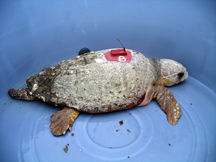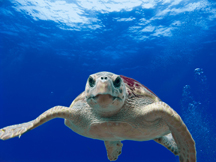Travel hazards: two studies start to map pollutant threats to turtles
09 May 2011
In a pair of studies-one recently published online* and the other soon-to-be published**- researchers at the Hollings Marine Laboratory (HML), a government-university collaboration in Charleston, S.C., report that persistent organic pollutants (POPs) are consistently showing up in the blood and eggs of loggerhead sea turtles, that the turtles accumulate more of the contaminant chemicals the farther they travel up the Atlantic coast, and that the pollutants may pose a threat to the survival of this endangered species.
 |
| Adult male loggerhead turtle fitted with a transmitter for satellite tracking of migratory patterns. |
POPs are a large group of man-made chemicals that, as their name indicates, persist in the environment. They also spread great distances through air and water, accumulate in human and animal tissues, infiltrate food chains, and may have carcinogenic and neurodevelopmental effects. POPs include banned substances such as DDT and toxaphenes, once used as pesticides; polychlorinated biphenyls (PCBs), once used as insulating fluids; and polybrominated diphenyl ethers (PBDEs), once used as flame retardants. While POPs have been recognized for many years as a health threat to loggerhead turtles (Caretta caretta), there is little scientific data available to help understand the nature and scope of the risk.
 |
| Up close and personal with a loggerhead turtle (Caretta caretta) in the Gulf of Mexico's Flower Garden Banks National Marine Sanctuary (about 170 kilometers, or 100 miles, off the Louisiana coast). |
In the first study*, HML researchers from NIST and the College of Charleston (C of C), working with the South Carolina Department of Natural Resources (SCDNR), used satellites to track 19 adult male loggerheads that had been captured in 2006 and 2007 by the SCDNR near Port Canaveral, Fla., fitted with transmitters on their backs and then released back into the wild. The animals, whose blood had been drawn at the time of capture and analyzed for POP concentrations, were followed for at least 60 days to learn their travel patterns. Ten turtles travelled north along the Atlantic coast, eventually migrating to ocean shelf waters between South Carolina and New Jersey. The other nine remained residents in Florida.
Blood plasma concentrations for all of the POPs examined were higher in the transient loggerheads, suggesting that they had eaten prey that were contaminated, such as crabs, in the northern latitudes during previous migrations. Additionally, the loggerheads that travelled farthest north had the highest POP concentrations in their systems. "This may be because the turtles' northern feeding grounds are subjected to higher levels of POPs from areas more populated and more industrialized than those in Florida," says C of C researcher Jared Ragland.
In the other HML turtle study**, Keller and researchers from the National Oceanic and Atmospheric Administration (NOAA), Florida Atlantic University and Duke University measured a large suite of POPs in loggerhead egg yolk samples collected from 44 nests in western Florida, eastern Florida and North Carolina. The team found that POP concentrations were lowest in western Florida, at intermediate levels in eastern Florida and highest in North Carolina.



















.jpg)










